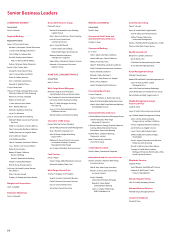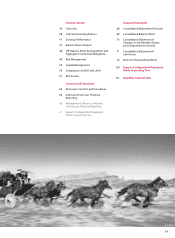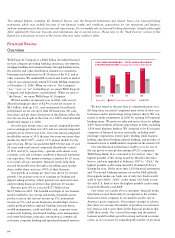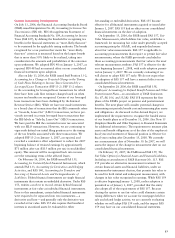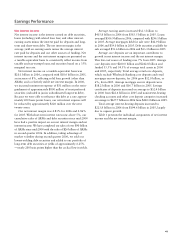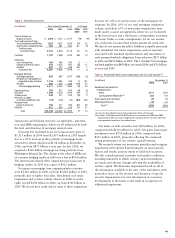Wells Fargo 2006 Annual Report Download - page 42
Download and view the complete annual report
Please find page 42 of the 2006 Wells Fargo annual report below. You can navigate through the pages in the report by either clicking on the pages listed below, or by using the keyword search tool below to find specific information within the annual report.
40
Pension Accounting
We account for our defined benefit pension plans using an
actuarial model required by FAS 87, Employers’ Accounting
for Pensions, as amended by FAS 158, Employers’ Accounting
for Defined Benefit Pension and Other Postretirement Plans –
an amendment of FASB Statements No. 87, 88, 106, and
132(R). FAS 158 was issued on September 29, 2006, and
became effective for us on December 31, 2006. FAS 158
requires us to recognize the funded status of our pension
and postretirement benefit plans on our balance sheet.
Additionally, FAS 158 will require us to use a year-end
measurement date beginning in 2008. We conformed our
pension asset and our pension and postretirement liabilities
to FAS 158 and recorded a corresponding reduction of
$402 million (after tax) to the December 31, 2006, balance of
cumulative other comprehensive income in stockholders’ equity.
The adoption of FAS 158 did not change the amount of net
periodic benefit expense recognized in our income statement.
We use four key variables to calculate our annual pension
cost: size and characteristics of the employee population,
actuarial assumptions, expected long-term rate of return on
plan assets, and discount rate. We describe below the effect
of each of these variables on our pension expense.
SIZE AND CHARACTERISTICS OF THE EMPLOYEE POPULATION
Pension expense is directly related to the number of employ-
ees covered by the plans, and other factors including salary,
age and years of employment.
ACTUARIAL ASSUMPTIONS
To estimate the projected benefit obligation, actuarial
assumptions are required about factors such as the rates of
mortality, turnover, retirement, disability and compensation
increases for our participant population. These demographic
assumptions are reviewed periodically. In general, the range
of assumptions is narrow.
EXPECTED LONG-TERM RATE OF RETURN ON PLAN ASSETS
We determine the expected return on plan assets each year
based on the composition of assets and the expected long-
term rate of return on that portfolio. The expected long-term
rate of return assumption is a long-term assumption and is
not anticipated to change significantly from year to year.
To determine if the expected rate of return is reasonable,
we consider such factors as (1) the actual return earned on
plan assets, (2) historical rates of return on the various asset
classes in the plan portfolio, (3) projections of returns on
various asset classes, and (4) current/prospective capital mar-
ket conditions and economic forecasts. Our expected rate
of return for 2007 is 8.75%, the same rate used for 2006.
Differences in each year, if any, between expected and actual
returns are included in our net actuarial gain or loss amount,
which is recognized in other comprehensive income. We
generally amortize any net actuarial gain or loss in excess of
a 5% corridor (as defined in FAS 87, Employers’ Accounting
for Pensions) in net periodic pension expense calculations
over the next five years. Our average remaining service
period is approximately 11 years. See Note 15 (Employee
Benefits and Other Expenses) to Financial Statements for
information on funding, changes in the pension benefit oblig-
ation, and plan assets (including the investment categories,
asset allocation and the fair value).
We use November 30 as the measurement date for our
pension assets and projected benefit obligations. If we were
to assume a 1% increase/decrease in the expected long-term
rate of return, holding the discount rate and other actuarial
assumptions constant, pension expense would decrease/increase
by approximately $54 million.
Under FAS 158, we will be required to use December 31
as a measurement date for our pension assets and benefit
obligations for fiscal years ending after December 15, 2008.
(See “Current Accounting Developments” for more information.)
DISCOUNT RATE
We use the discount rate to determine the present value of
our future benefit obligations. It reflects the rates available
on long-term high-quality fixed-income debt instruments,
and is reset annually on the measurement date. As the basis
for determining our discount rate, we review the Moody’s
Aa Corporate Bond Index, on an annualized basis, and the
rate of a hypothetical portfolio using the Hewitt Yield Curve
(HYC) methodology, which was developed by our indepen-
dent actuary. The instruments used in both the Moody’s Aa
Corporate Bond Index and the HYC consist of high quality
bonds for which the timing and amount of cash outflows
approximates the estimated payouts of our Cash Balance
Plan. We used a discount rate of 5.75% in 2006 and 2005.
If we were to assume a 1% increase in the discount rate,
and keep the expected long-term rate of return and other
actuarial assumptions constant, pension expense would
decrease by approximately $37 million. If we were to assume
a 1% decrease in the discount rate, and keep other assump-
tions constant, pension expense would increase by approxi-
mately $103 million. The decrease in pension expense due to
a 1% increase in discount rate differs from the increase in
pension expense due to a 1% decrease in discount rate due
to the impact of the 5% gain/loss corridor.




